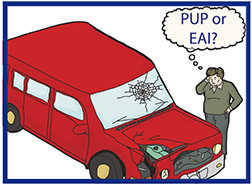SPECIAL FEATURE
Ask an Expert rESPONSES
 Bob is driving his own car to the office supply store. He is doing an errand for his employer, Acme Anvil Co. He has a personal auto policy with $300,000 of liability coverage, collision, and a Personal Umbrella [PUP] of $1,000,000. Acme has a Business Auto Policy [BAP] with hired and non-owned auto coverage at a limit of $1,000,000. Acme's insurance includes "Employees as Additional Insured" [EAI]. Bob is driving his own car to the office supply store. He is doing an errand for his employer, Acme Anvil Co. He has a personal auto policy with $300,000 of liability coverage, collision, and a Personal Umbrella [PUP] of $1,000,000. Acme has a Business Auto Policy [BAP] with hired and non-owned auto coverage at a limit of $1,000,000. Acme's insurance includes "Employees as Additional Insured" [EAI].
Bob causes an accident that results in damage to his car and $10,000 damage to a stopped vehicle. There are three passengers in the car who all claim injuries of various severity. They sue Bob and Acme. The court awards the injured passengers $500,000 from Bob and $750,000 from Acme.
Bob's auto insurance pays for the damage to his car (less deductible), his legal expenses and up to $290,000 of the judgment (his $300,000 limit of liability less the $10,000 paid for the damage to the other vehicle.) Acme's insurance pays for their legal fees and the $750,000 award, leaving just the judgement against Bob in excess ($210,000) of his PAP coverage.
With regard to the judgment against Bob in excess of his PAP: Which do you think would kick in first, Bob's PUP or Acme's EAI? Why?
Here are the responses from the Two for Tuesday readers. The winner (chosen at random) of a $10 gift card is Karen W Smith of Walter O. Rogers Insurance Agency LLC (NY).
Below is the Ask an Expert response from Chris Boggs of Virtual University.
Here is the reality of the "business use" exclusion in the ISO PAP - effectively, there ain't one other than public or livery conveyance exclusion (which is absolute, but alive with ambiguity - but that's a story for a different day). However, there are non-ISO PAP forms that do exclude ANY business use; I wrote an article on it. Most PAPs I've seen follow the ISO language and coverage business use other than public or livery conveyance. Further, the PAP includes liability coverage for the use of non-owned autos (as excess over other insurance) - but that's not the conversation for today.
In ISO's PAP, the employer is granted protection as an insured IF they can be and are held vicariously responsible for the accident. So, as we discussed, the PAP is primary for the named insured (the employee) and the employer. Lacking an umbrella or excess policy, the BAP is secondary - for the EMPLOYER only. And to add insult to injury, the employer's BAP can subrogate against the employee to recover any loss it pays. Why? Because in the situation described, the employee is NOT extended insured status in or by the BAP because of the exclusion for the owner of the non-owned vehicle:
-
Who Is An Insured
The following are "insureds"
b. Anyone else while using with your permission a covered "auto" you own, hire or borrow except
("except" means there is no coverage for):
(2) Your "employee" if the covered "auto" is owned by that "employee" or a member of his
or her household.
Enter the Employees as Insureds (CA 99 33) endorsement. This doesn't change the order of payment (the PAP is still primary), it simply extends coverage to the employee if the claim exceeds the employee's coverage.
When the umbrella is added to the mix, is the order changed? It depends on the umbrella/excess policy in place. In general, I believe the BAP will still be excess because of the Other Insurance wording in the BAP which, in relation to non-owned autos, reads: "5. Other Insurance a. …. For any covered "auto" you don't own, the insurance provided by this Coverage Form is excess over any other collectible insurance."
Many if not most personal umbrella/excess policies state that the coverage is excess unless another form is written or responds specifically as excess. Since the employee is not a named insured on the BAP, any coverage the BAP provides is specifically excess. The named insured's policy or policies logically apply as primary because that's who caused the accident. The BAP is excess because it is protecting the entity vicariously (not directly) liable for the injury or damage.
How is Hired and Non-Owned coverage added to the BAP? When Symbol 1 is used, there is no need for any other symbol. Any liability symbol other than Symbol 1 requires the use of Symbol 8 (hired) and Symbol 9 (non-owned). Symbol 9 extends to the employee-owned auto.
|
Regulating the Home Rental Market
 The number of residential rental properties is increasing and that has led to an increase in attention by local governments in places such as Naples, Boston, and Cincinnati. Some short-term renters may throw loud parties, mistreat the rental property or conduct illegal activity. Combine the loss of long-term housing with increasing lost tax revenue and it's no wonder so many local governments are beginning to craft and new rules and restrictions. Some are simple while others impose a minimum rental period of up to six months. Other areas aren't taking action yet but may do so in the future. The number of residential rental properties is increasing and that has led to an increase in attention by local governments in places such as Naples, Boston, and Cincinnati. Some short-term renters may throw loud parties, mistreat the rental property or conduct illegal activity. Combine the loss of long-term housing with increasing lost tax revenue and it's no wonder so many local governments are beginning to craft and new rules and restrictions. Some are simple while others impose a minimum rental period of up to six months. Other areas aren't taking action yet but may do so in the future.
Your clients who own residential rental property need to be aware of any changes in local laws and regulations. Sharing sites such as Airbnb say they they are not regulators and that the property owners are responsible for following local laws and regulations.
While home (and room) sharing can be lucrative for homeowners, it exacerbates the typical homeowners risks. Recognizing this, Lexington Insurance Company has its series of enhancements to LexElite® Homeowners Insurance: LexShareSM HOME Rental Coverage (LexShare HOME), explicitly designed to respond as the sharing economy reshapes the home and condo rental market. LexShare HOME extends homeowners protection expressly where short- and long-term landlords need it--providing coverage certainty with an expanded definition of "residence premises" and raising the roof on protection for losses from property damage, theft, and more.
Key coverage highlights include:
-
A broad definition of "residence premises" that eliminates any grey areas in coverage for primary and secondary rental properties, and expressly encompasses both short- and long-term rentals regardless of whether they are secured through online peer-to-peer websites or traditional real estate brokers.
-
Protection for rental of other structures on the "residence premises," such as a converted garage apartment - deleting the exclusion of other structures rented or held for rental in the standard homeowners policy.
-
Increased coverage for damage to landlord's furnishings, including appliances, carpeting, and other household furnishings, in each apartment on a "residence premises," eliminating the $2,500 coverage cap in a standard homeowners policy.
-
Enhanced protection for personal property, tripling - or more - the standard Special Limits of Liability in key areas. For example, LexShare HOME provides limits of $10,000 on watercraft of varying types; $5,000 for loss by theft of jewelry, watches, precious, and semiprecious stones; $7,500 for loss by theft of silverware, goldware, platinumware, and firearms; $7,500 on property used primarily for "business" purposes; and $4,500 on trailers or semitrailers as well as $4,500 on certain electronic apparatus and accessories.
-
Coverage for theft of personal property from that part of a "residence premises" rented to others.
-
$100,000 Watercraft Liability coverage for certain watercraft rented to others, such as jet skis, small sailboats and powerboats, canoes, kayaks, and rowboats. Standard homeowners policies provide no coverage whatsoever for watercraft rented to others.
-
Express coverage for tenant-caused damage to trees, shrubs, plants or lawns on primary and secondary rental properties.
LexShare HOME Rental Coverage is the newest addition to Lexington's suite of enhancements to LexElite® Homeowners' Insurance - each enhancement is designed to help consumers keep pace with the fast-moving risks of today's world. Additional endorsements include: Lex CyberSafetySM Coverage, Upgrade to Green® Residential, Eco-Homeowner® Mandatory Evacuation Response Coverage, and LexElite® Pet Insurance.
The Non-standard Homeowners, Renters, Condominium, Rental Dwellings, Vacant Dwellings is available all in states except Hawaii. To learn more visit Big "I" Markets or contact Herbert Decuers at hdecuers@insureresponse.com.
|
|
VU Webinars and Lightning Learning
Virtual University
|
WEBINARS - Two-hours with CE in select states.
View the complete calendar, registration links and see what states have CE approval online. Registration includes live webinar, on-demand recording and a transcript.
LIGHTNING LEARNING - Twenty minutes each with a focus on Meeting Production Goal Requires More Work Than You Think
-
May 1 - 11:30 a.m. ET - How Much Time Do You Actually Spend Adding New Business?
-
May 16 - 11:30 a.m. ET - How Much NEW Business Must You Place to Make Goal?
-
May 22 -11:30 a.m. ET - How Do You Get to the TOP of the Underwriting Pile?
Register once for the monthly Lightning Learning package and receive all sessions for one low price. Registration includes live presentations and on-demand recordings.
VU Webinar and Lightning Learning questions can be sent to VU staff. The 2019 calendar and all links are available here.
|
|
|
Be one of the first five with the correct answers and win a $5 gift card (Starbucks, Dunkin' Donuts, Baskin Robbins, or Krispy Kreme).
Don't forget to answer the Tie Breaker!
1. An early depiction of cyber theft in films was carried out by actor Richard Pryor. What character was he playing, and in which movie?
2. On this date in 1867 Queen Victoria & Napoleon III turn down plans for what construction project, finally completed more than 100 years later?
3. Which city isn't "taking action yet" on regulating home rentals in the Non-standard Homeowner article?
TIE BREAKER
TB - How did Stanley (an Australian border collie) respond when asked about his viral ball-catching video?
|
BIG "I" MARKETS SALE OF THE WEEK
|
|
|
|
|
|
 |